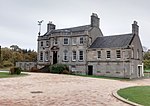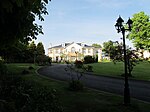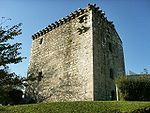Newton Mearns
Commons category link is locally definedGreater GlasgowJews and Judaism in ScotlandNewton MearnsPopulated places established in 1832 ... and 1 more
Towns in East Renfrewshire

Newton Mearns (Scots: The Mearns; Scottish Gaelic: Baile Ùr na Maoirne [ˈpalə ˈuːɾ nə ˈmɯːrˠɲə]) is a suburban town and the largest settlement in East Renfrewshire, Scotland. It lies 7 miles (11 km) southwest of Glasgow City Centre on the main road to Ayrshire, 410 feet (125 m) above sea level. It has a population of approximately 26,993, stretching from Whitecraigs and Kirkhill in the northeast to Maidenhill in the southeast, to Westacres and Greenlaw in the west and Capelrig/Patterton in the northwest.It is part of the Greater Glasgow conurbation. Its name derives from being a new town of the Mearns (from Scottish Gaelic "a' Mhaoirne" meaning a stewartry).
Excerpt from the Wikipedia article Newton Mearns (License: CC BY-SA 3.0, Authors, Images).Newton Mearns
Ayr Road,
Geographical coordinates (GPS) Address Nearby Places Show on map
Geographical coordinates (GPS)
| Latitude | Longitude |
|---|---|
| N 55.7716 ° | E -4.3347 ° |
Address
Ayr Road
Ayr Road
G77 6AE , Paidmyre
Scotland, United Kingdom
Open on Google Maps





